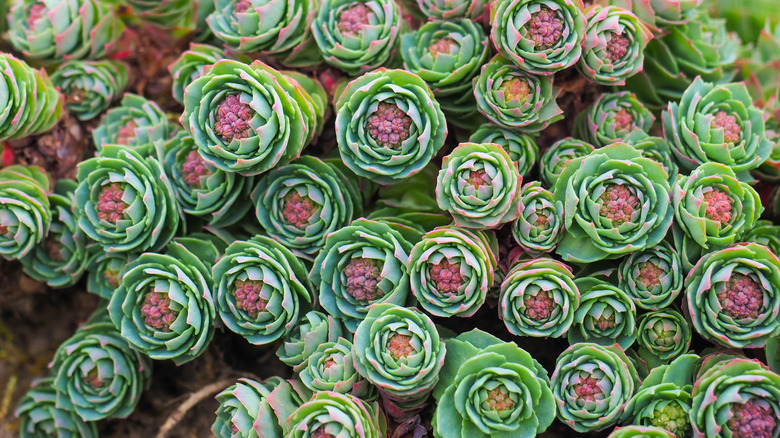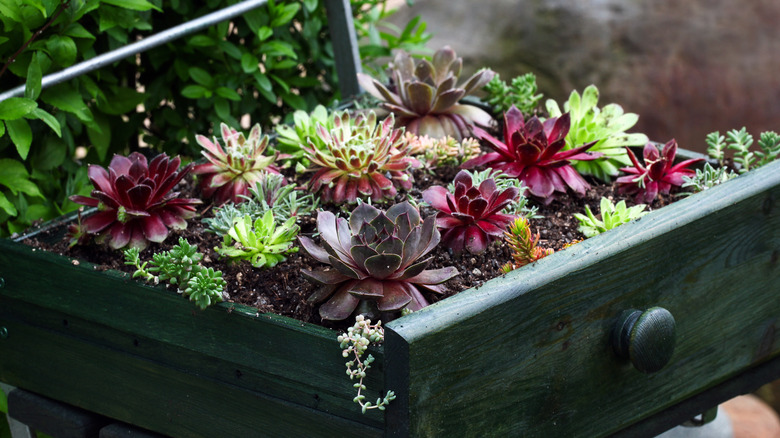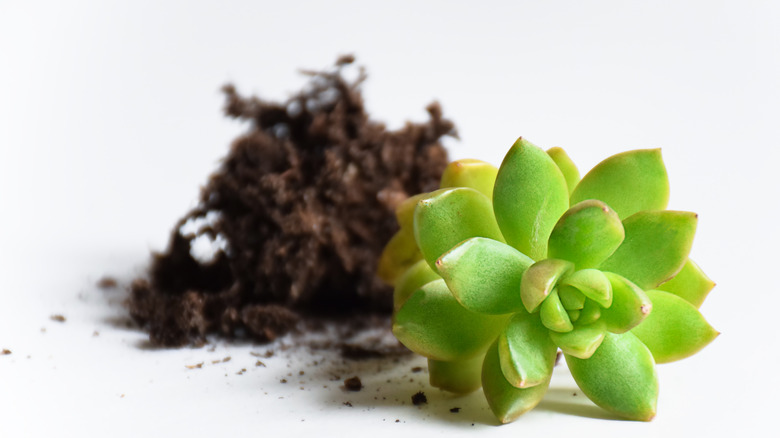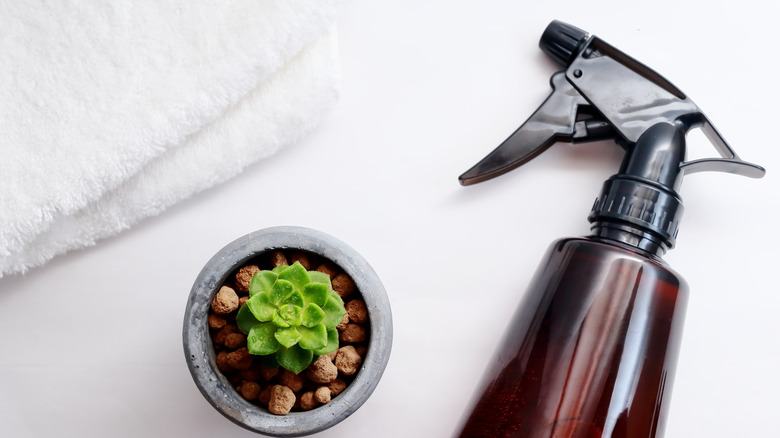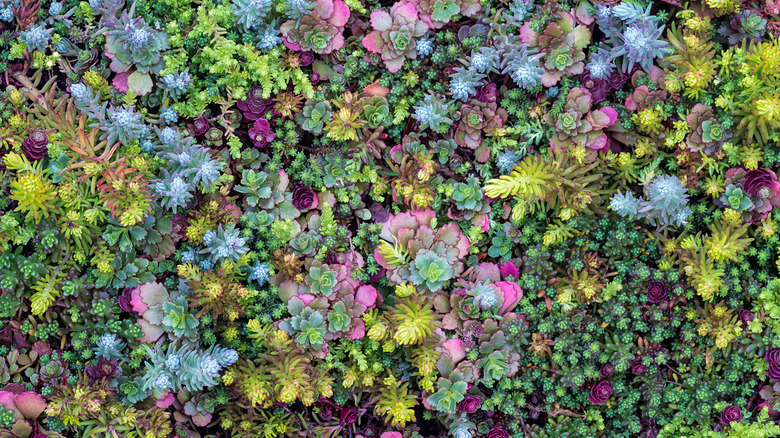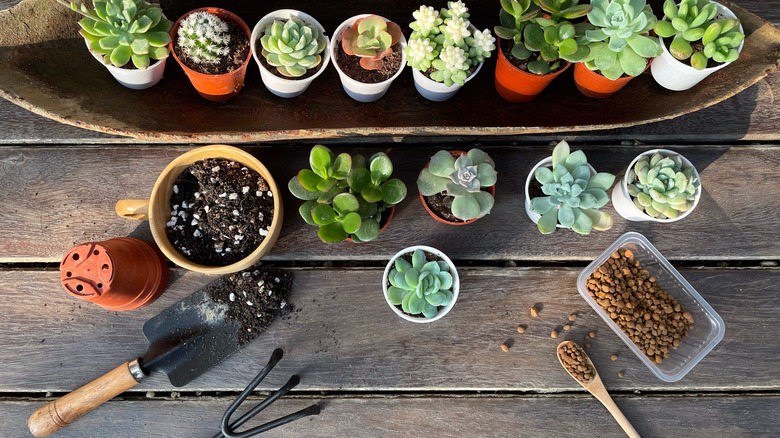How To Care For A Stonecrop Succulent
Stonecrop succulents (scientific name: Sedum, and in some cases, hylotelephium, though regularly still sold under the sedum moniker) make up some of the most commonly gifted indoor succulent houseplants, says Gardening Know How. From the jade plant to the kalanchoe, stonecrop succulents can offer everything from vibrant color to lush groundcover to nice stem height.
Native to Europe & East Asia, stonecrop succulents make up nearly 600 species within the crassulaceae family, says Succulents Addiction. The stonecrop name comes from their tenacity to flourish in gritty, dry soil, and they have a reputation for being particularly easy to grow. Most of the plants feature a rosette-looking "bloom" of thick, moisture-storing leaves. Some of the plants showcase colors on their leaves, like the Japanese stonecrop that The Spruce points out has silver-blue leaves with red edging.
Stonecrop succulents are non-toxic to your house pets and may be more than just pretty in your home since, according to One Medical, certain stonecrop succulent leaves can be sautéed for your family dinner stir-fry or clipped and eaten raw in your next salad. For more on stonecrop succulents, check out the following care and growing tips.
How to use stonecrop succulent in a garden
Stonecrop succulents make great additions to indoor spaces or outdoor gardens, says Succulent City. They can handle colder temperatures and are not fussy if soil conditions are rough, so long as you do not let them sit in pooled water. That said, they do vary quite a bit in size and height, so make sure that you know what you are getting when you plan what stonecrop succulents to add to your garden and where.
The stonecrop succulent varieties that grow tall can hit up to 3 feet. According to Succulent Alley, these typically bloom in August or September with pink, burgundy, or white flowers. One example is autumn joy, which is an upright, vibrant stonecrop succulent to consider if your garden needs plants with height, says The Spruce. It rewards its gardener with pretty little pink blooms that form a 3 to 6-inch cluster in the early fall, which then transition to a rose color and then burnt orange as the colder weather hits.
On the other hand, if short, widespread plants or even groundcover is what your garden is calling for, you have plenty of stonecrop succulents to choose from. Try the white sedum for that section of your garden that arcs into a bit of an embankment, though you will need patience since they can grow rather slowly. Or consider the cascade stonecrop to leverage its easy spread and pretty yellow blooms in the summer.
How to grow stonecrop succulents
Stonecrop succulents have been dubbed the easy plant for the lazy gardener since they are that easy to grow, maintain and propagate, says Succulent Alley. If you simply avoid overwatering and plant them in quick-drain soil, these succulents offer a lot of vibrancy of color and form for very little effort.
To find out which section of your garden works best, Succulent City suggests you dig a hole about a foot deep and fill that with water. If it has not drained after 30 minutes, you will want to add perlite, sand, or something to the top 3 inches of topsoil to make it more loose and easy draining. This is an important step to avoid root rot and should be considered when potting stonecrop succulents as well. When potting, be sure to use pots with drain holes on the bottom.
According to The Spruce, planting stonecrop succulents is as easy as tucking a single branch or leaf into suitable, easy-draining soil. Vertical-growing varieties will root quickly. Horizontal-growing varieties are also easy to develop into a lush spread, but unlike other ground cover that can become a nuisance, stonecrop succulents have shallow roots that can easily be pulled and replanted should you decide to move them or remove them altogether.
Try planting your stonecrop succulent when the winter weather turns warm or at least when your area has seen the last frost of the season. However, do not wait until the heat of summer.
How to care for stonecrop succulents
Outdoor stonecrop succulents do best in full sun for up to six hours a day. For potted plants, World of Succulents suggests you thoroughly water your stonecrop succulents spring through fall, but only once the soil in your pot has dried out completely, noting that will be less and less often during the dormant winter months. Keep indoor stonecrop succulents near a window for light and make sure to empty pooling water out of the drainage tray under your pot.
Stonecrop succulents can manage fine without fertilizer, but a diluted fertilized feeding once every other spring might be nice, says Plant Addicts. They suggest sprinkling a granular mix of nitrogen, phosphorus and potassium on the soil around your stonecrop succulents, or a half-strength liquid fertilizer, then water thoroughly. However, have a very light hand when it comes to fertilizing stonecrop succulents as too much fertilizing can make your plants floppy and weak.
Aside from cleaning up stray or damaged leaves or branches after a tough winter, stonecrop succulents need little or no pruning.
Varieties of stonecrop succulents
Flowering, sturdy, and hailing from mountainous tropics, the stonecrop succulent genus (scientific name: Sedum) from the plant family Crassulaceae is huge. According to Succulents Addiction, stone succulents account for around 600 varieties that are able to grow in rocky soil. They can grow up to 3 feet tall or spread wide, creating a thick groundcover with shallow roots that make this plant easy to control, says Garden Beast. Their moisture-holding leaves wrap around each other to make little rosettes which ultimately sprout blooms that can last well into cooler months, depending on environment and variety.
Here are five stonecrop succulent favorites:
- Woodland stonecrop (sedum ternatum) – this plant is common across the United States, from Iowa to the Appalachian Mountains.
- Dragon's blood sedum (sedum coccineum) – this plant blooms with pretty pink flowers and grows to about 6 inches tall.
- Major corsican stonecrop (sedum dasyphyllum) – this plant is a creeping stonecrop that has small bluish-grey leaves that create a tight, lush groundcover.
- Wildfire stonecrop (sedum sunsparkler) – this plant blooms pink flowers and attracts butterflies.
- Cascade stonecrop (sedum divergens) – according to The Spruce, this plant can spread several feet and blooms yellow flowers.
How to repot stonecrop succulents
Stonecrop succulents are easy to repot and propagate. They can be grown from leaf cuttings, but Succulent Plant Care suggests stem cuttings are an even more failsafe way to go when propagating your plant. Start by cutting a stem, then setting that aside to dry out. After a day or two, the ends should have developed a sealed callous. Plant your cutting callous-side down into your easy-drainage soil. For potted plants, use a cactus soil mix and add perlite or coarse sand for extra drainage.
Until the cutting roots, keep it shaded and watered when it is feeling dry. Roots should develop in a few weeks, and budding growth should develop in four to six weeks. At that point, give your stonecrop succulent more direct sunlight and reduce watering it to every other week.
Give your stonecrop succulents plenty of light. Outside, they like partial shade to full sun, and inside, an east-facing window may work best. Enough light and not too much water will keep your stonecrop succulents thriving for years.
